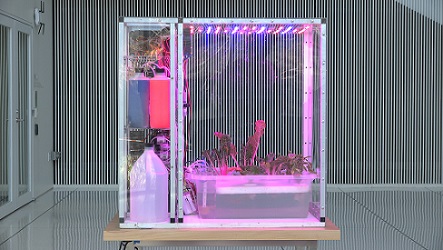Hardware
The bill of materials for a PFC consists of over 400 parts, which forms the two major sections of the hardware:
- The Growing Chamber
- The Electronics Chamber
The growing chamber is like an automated 3’ x 3’ x 3’ terrarium, where sensors supply heat, light, water, and nutrients to the plant. While this enclosure is insulated to stabilize the environment in terms of temperature and humidity control, it also includes a large window to allow humans to visually monitor the harvest.
The electronics chamber is also insulated, but for altogether different reasons. One of its purposes is to store the raspberry pi, which is the small computer where the climate recipe software is loaded. Likewise, the Arduino, which connects and monitors the sensors, resides within the electronic chamber. With such sensitive cargo, it is up to the electronics chamber to maintain a cool and dry atmosphere. Therefore, it is protected by a clear, thick custom-fitted casing, which sheilds its contents from the external environment as well as the wet growing chamber.
Below are some of the major components of the PFC:
- Shell – Serves as the growing chamber.
- Sensors – Monitors growth elements such as carbon dioxide, dissolved oxygen, and root zone temperature.
- Arduino – Collects data from sensors and then relays it to the Raspberry Pi.
- Raspberry Pi – Stores data from Audrino and provides digital farmers with a collective dashboard where they can revise conditions accordingly.
Software
The software consists of hundreds of files that serve in three major capacities:
- The User Interface
- Sensor Control
- The Climate Recipe
Below is a list of each open source sofware component:
- MIT Open Agriculture User Interface
- Operating systems: Derived from those utilized on the Raspberry Pi and Arduino.
- Software languages: Python, C++, JavaScript, HTML, and CSS
- MIT Sensor Control System Software
- For more details and specs regarding the programming languages implemented in this project please visit: https://github.com/openaginitiative
- Climate Recipe: Consists of instructions, software programs, and data, that are stored in the computer. These instructions run the sensors which provide the right amount of inputs at the appropriate times to produce the desired physical qualities of the plant.





